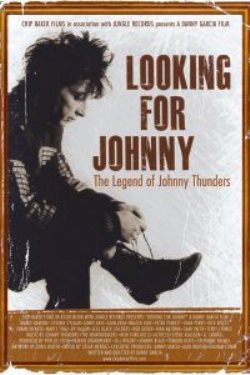If that seems too harsh then ask yourself: How many musicians wanted to change their band’s name to The Junkies or posed for portraits with a syringe in their hatband? Thanks to documentaries like “Looking For Johnny” you can now make your own call.
There’s a forerunner to this, a Lech Kowalski film that seemed to surface briefly at festivals in the mid-‘80s and do the rounds among bootleggers. There were multiple cuts and the two versions I’ve seen were a mess. Many fans felt Kowlaski had exploited Johnny. There was a sense of a wagon being hitched. The filming did spawn an excellent 1982 live album, “Stations of The Cross”, on which you can experience Johnny and one of his many rent party bands in all their sweaty, crude glory.
“Looking for Johnny” is a mile ahead in production values. It’s a chronological telling of the Thunders tale, tracing his arrival as a New York Doll, discovery of heroin (hey, thanks, Iggy!) and spiral towards an inevitable premature demise. The Heartbreakers’ arrival in the UK, where their influence could be charted by how many local bands got hooked on smack, is told in matter-of-fact style – in some cases by the people they got hooked. The doomed relationship with the appropriately-named Track label, sonically-flawed “LAMF” album and Johnny moving on to a solo career, are charted, as is Thunders’ slow and steady demise.
“Looking for Johnny” doesn’t chose to rake over the coals of conspiracy theories too hard, putting out the post mortem deduction that Johnny more than likely had lymphoma. Him not being the sort of guy who would have put a lot of stock in medical insurance, he was always more likely than most to check out earl – probably with an underlying acceptance of his fate. The bottom line here is that John Genzales was somebody who could never be happy. Drugs were a means to an end.
Whether through accident or design, much of the story is told by women. Heartbreakers den mother Gail Higgins, photographer (and Wayne Kramer’s ex) Marcia Resnick, definitive biographer Nina Antonia and Jerry Nolan’s longtime girlfriend Phyllis Stein are important voices here. Q: “Who Needs Girls?” A: Johnny did.
Also prominent are Lenny Kaye, ex-Dolls manager Marty Thau (R.I.P.), Dolls sound guy Nite Bob and onetime Heartbreakers manager Lee Black Childers (also R.I.P.) Of the then-surviving Heartbreakers, the wonderful guitar foil and now stockbroker, Walter Lure, and wizened bassist Billy Rath (R.I.P.) chime in. Richard Lloyd looks to have taken on the maxim about living well being the best revenge while, by way of contrast, Alan Vega (then aged approximately 75) looks impossibly old.
Omnipresent photographer Bob Gruen’s observations are some of the sharpest while Syl Sylvain surely is similarly one of the most coherent survivors of the time. Notably M.I.A. are David Johansen and Richard Hell and that’s a pity; respectively they’re probably the most bombastic and pithy observers of the NYC punk scene still standing. Also absent are the no doubt countless people J.T. burned along the way - some of them happy to be used, of course.
In the end you have to ask yourself if you learned anything new. The answer that if you’re reasonably familiar with Thunders, Probably Not. That’s not entirely director Danny Garcia’s fault. The Johnny Thunders Story has been more than well told before (check out Nina Antonia’s “In Cold Blood” book for the detail) but why Johnny ended up such a fatalist isn’t really addressed, except in generalised terms. There’s sympathy here but no unnecessary glorification.
Essential stuff if you have a remote interest in Thunders or NY punk.


 Seems not so long ago (and in fact, it was the late 1980s) that the shadow of a still breathing, although not always fully-functioning, Johnny Thunders was almost everywhere you looked. His records filled the racks and every second person in a band wanted to look like, if not be, JT. As in buying the T-shirt with no need to tap a vein.
Seems not so long ago (and in fact, it was the late 1980s) that the shadow of a still breathing, although not always fully-functioning, Johnny Thunders was almost everywhere you looked. His records filled the racks and every second person in a band wanted to look like, if not be, JT. As in buying the T-shirt with no need to tap a vein.